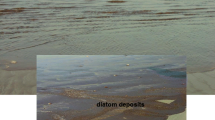Abstract
Seasonal variations of radiolarian and diatom fluxes in the central South China Sea during 1993–1995 were overwhelmingly controlled by monsoon climate. Radiolarian and diatom increased obviously during the Northeast (from November to February) and Southwest (from June to September) monsoons and decreased during the periods between the monsoons. The change of circulation driven by the monsoons improved water exchange in the different areas that brought rich nutrient materials for the surface microplankton, thereby enhancing radiolarian and diatom fluxes. Variation of radiolarian flux coincided with organic carbon flux, surface primary and export productivities. High radiolarian flux corresponded to high surface primary productivity. Radiolarian and diatom fluxes raised abnormally during 1994–1995 could be attributed to the El Nino event during the period.
Similar content being viewed by others
References
Bernsten, R. E., Betzer, P. R., Takanashi, K., Radiolarians from the western North Pacific Ocean: a latitudinal study of their distributions and fluxes, Deep-Sea Research, 1990, 37(11): 1677.
Gowing, M. M., Seasonal radiolarian flux at the Vertex North Pacific time-series site, Deep-Sea Research, 1993, 40(3): 517.
Boltovskoy, D., Alder, V. A., Ablmann, A., Annual flux of radiolaria and other shelled plankters in the eastern equatorial Altantic at 853 m: Seasonal variations and polycystine species-specific responses, Deep-Sea Research, 1993, 40(9): 1863.
Takahashi, K., Honjo, S., Radiolarian skeletons: size, weight, sinking speed, and residence time in tropical pelagic oceans, Deep-Sea Research, 1983, 30(5A): 543.
Takahashi, K., Radiolarian flux and seasonality: climatic and El Niño response in the Pacific, 1982–1984, Global Biogeochemical Cycles, 1987, 1(3): 213.
Weinheimer, A. L., Carson, T. L., Wigly, C. R. et al., Radiolarian responses to recent and Neogene California El Niño and anti-El Niño events, Palaeogeogr., Palaeoclimatol., Palaeoecol., 1986, 53: 3.
Pisias, N. G., Murray, D. W., Roelofs, A. K., Radiolarian and silicoflagellate response to oceanographic changes associated with the 1983 El Niño, Nature, 1986, 320(20): 259.
Casey, R. E., Weinheimer, A. L., Nelson, C. O., California El Niños and related changes of the California current system from recent and fossil radiolarian records, Geophys. Monogr., 1989, 55: 85.
Welling, L. A., Pisias, N. G., Johnson, E. S. et al., Distribution of polycystine radiolarian and their relation to the physical environment during the 1992 El Niño and following cold event, Deep-Sea Research II, 1996, 43(4–6): 1413.
Gowing, M. M., Coale, S. L., Fluxes of living radiolarians and their skeletons along a northeast Pacific transect from coastal upwelling to open ocean waters, Deep-Sea Research, 1989, 36(4): 561.
Wiesner, M. G., Zheng, L., Wong, H. K., Fluxes of participate matter in the South China Sea, in Particle Flux in the Ocean (eds. Ittekkot, V., Schäfer, P., Honjo, S. et al.), New York: John Wiley and Sons, 1996, 91–154.
Wang Rujian, Abelmann, A., Pleistocene radiolarian biostratigraphy in the South China Sea, Science in China, Ser. D, 1999, 42(5): 536.
Chen Jianfang, Zheng Lianfu, Wiesner, M. G. et al., Estimations of primary production and export production in the South China Sea based on sediment trap experiments, Chinese Science Bulletin, 1998, 43(7): 583.
Zhang Qin, Ding Yihui, Zhou Qinfang, A study of basic features and genesis mechanism of El Niño events during 1991–1995 (in Chinese with English abstract), in The Recent Advances in Asian Monsoon Research—The Proceedings of P. R. China-Japan Cooperation Research Project on Asian Monsoon Mechanism (eds. He Jinhai, Ding Yihui, Chen Longxun), Beijing: Meteorology Press, 1996, 150–161.
Chen Jianfang, Zheng Lianfu, Chen Ronghua et al., Fluxes and constituents of particulate matter in the South China Sea in comparison with sediment accumulation rates, Acta Sedimentologica Sinica (in Chinese with English abstract), 1998, 16(3): 14.
Climate Prediction Center, Near real-time analyses: ocean/atmosphere, Climate Diagnostics Bulletin, 1999(11): 7.
Feng Xiaowei, Sun Zhaobo, The influence of ENSO on the East-Asian summer monsoon intensity, Journal of Nanjiang Institute of Meteorology (in Chinese with English abstract), 1998, 21(2): 196.
Shi Neng, Yang Yongsheng, Main characteristics of East-Asian summer/winter monsoon index for 1873–1996, Journal of Nanjing Institute of Meteorology (in Chinese with English abstract), 1998, 21(2): 208.
Author information
Authors and Affiliations
Corresponding author
About this article
Cite this article
Wang, R., Lin, J., Zheng, L. et al. Siliceous microplankton fluxes and seasonal variations in the central South China Sea during 1993–1995: monsoon climate and El Niño responses. Chin. Sci. Bull. 45, 2168–2172 (2000). https://doi.org/10.1007/BF02886323
Received:
Issue Date:
DOI: https://doi.org/10.1007/BF02886323




